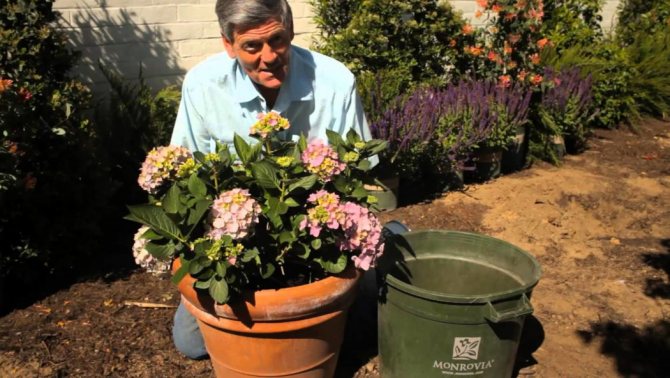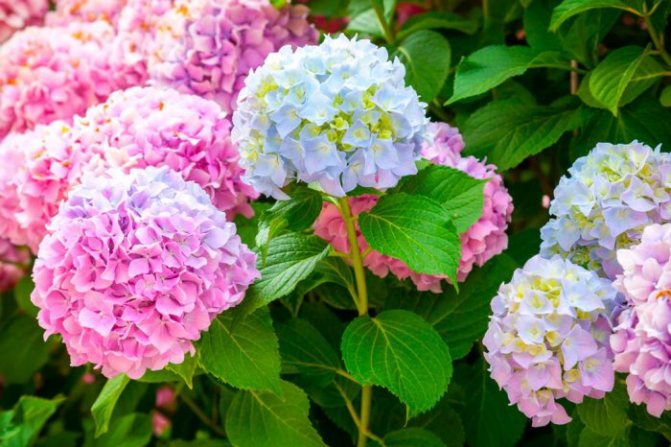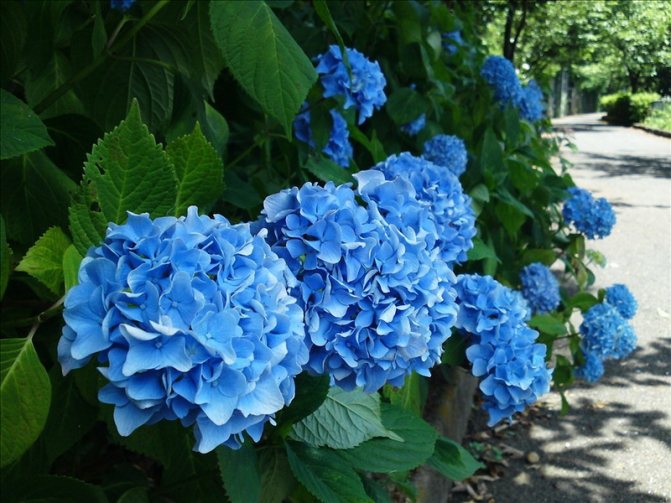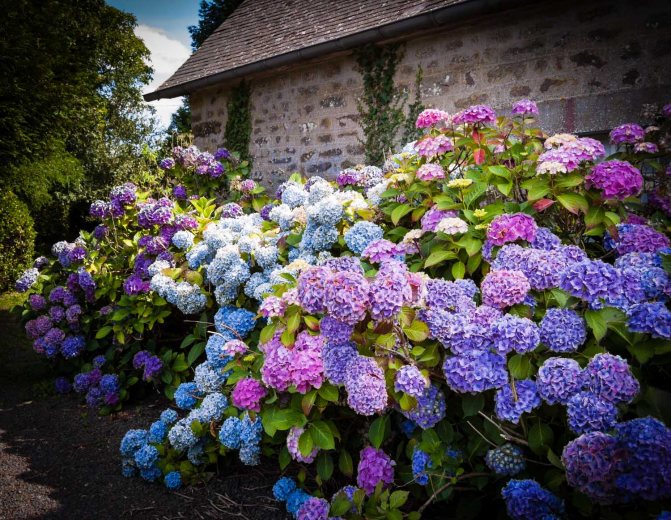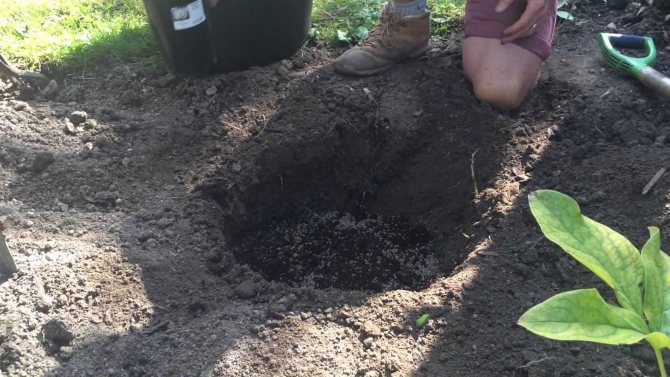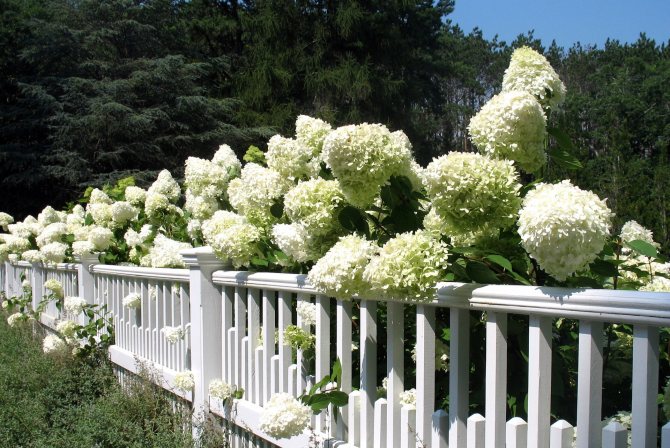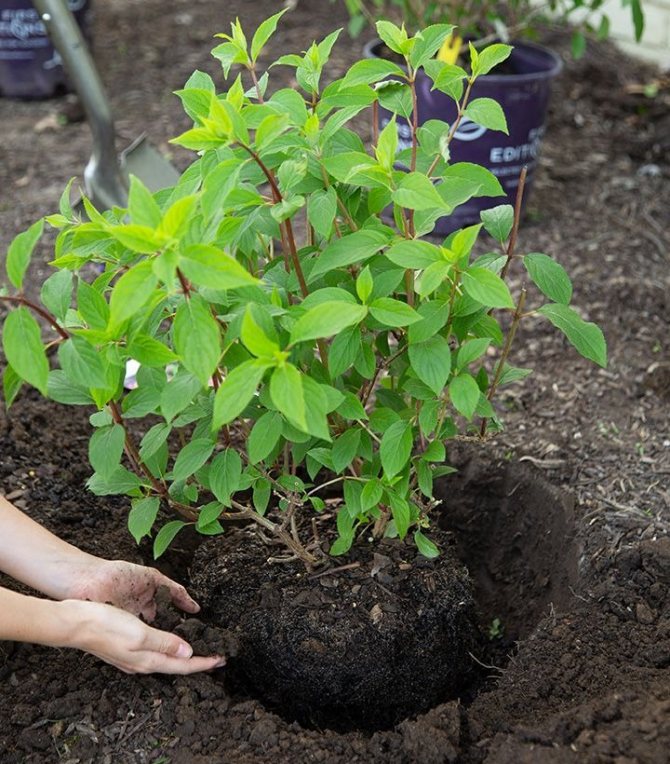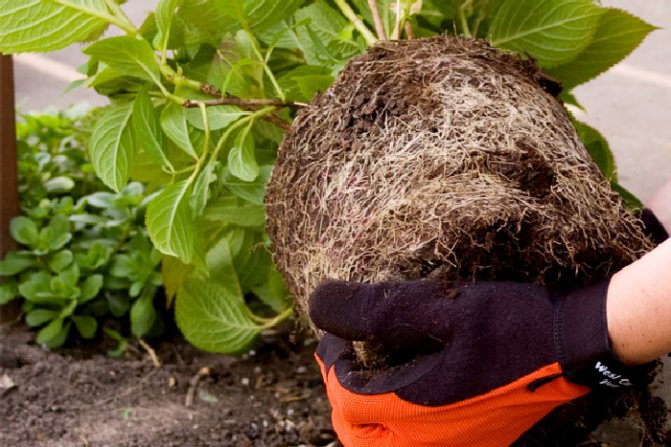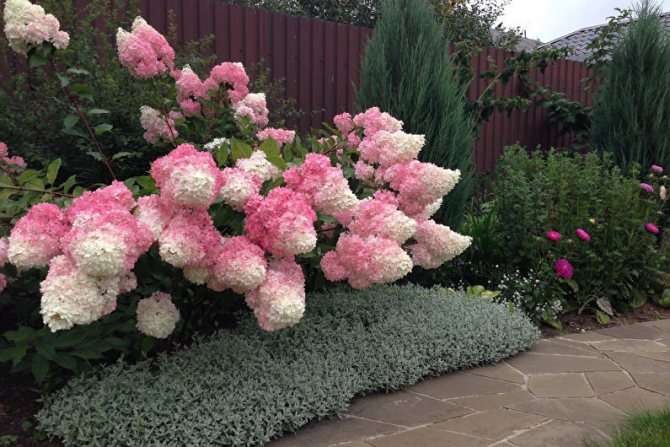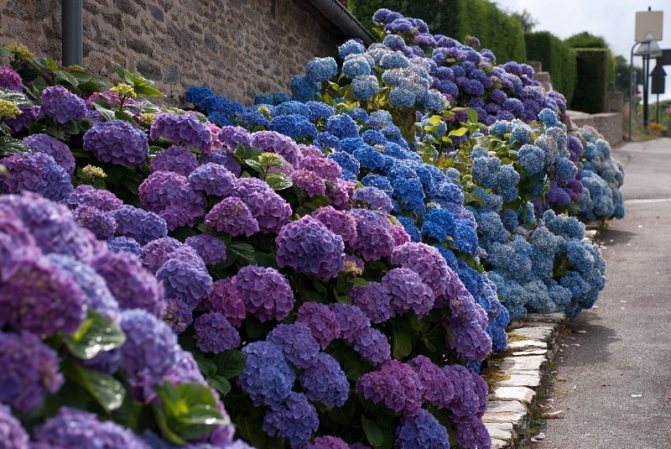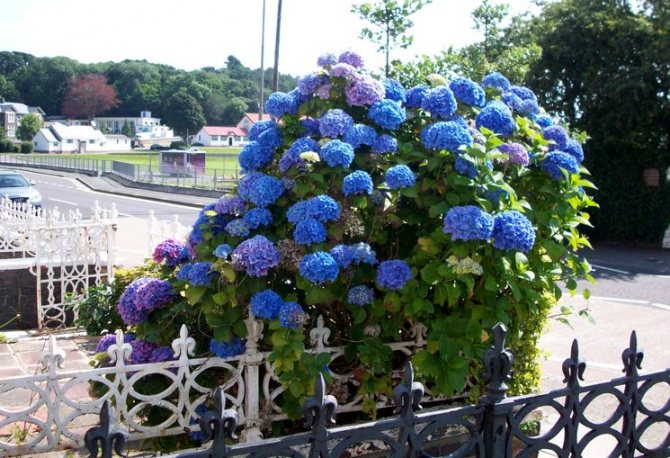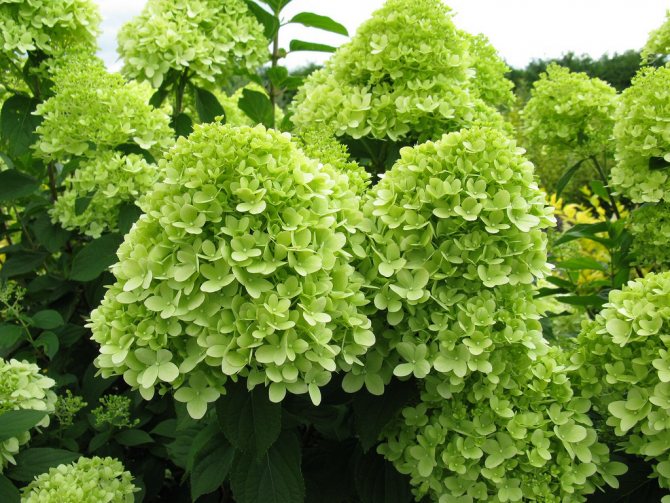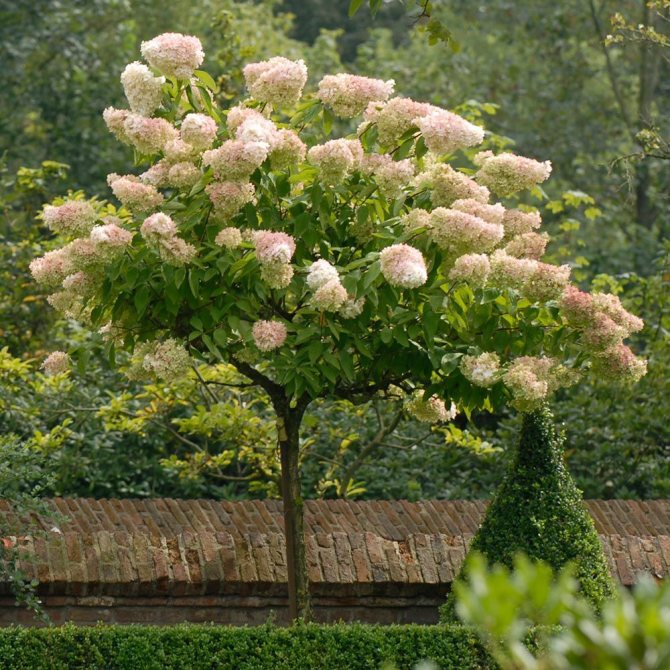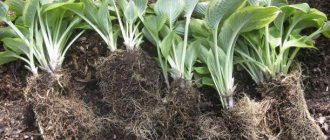Is it possible to transplant hydrangea
This shrub tolerates transplantation without any problems, but only if the transplant is done correctly and accurately, taking into account the plant's requirements for location, the need for water and light. When digging up an adult bush, if possible, they try to keep the soil ball in which the roots are located. The hydrangea, previously grown in a pot, will take root in a new place best of all, since its root system is not disturbed.

Features of transplanting room hydrangea from pot to pot
Why hydrangea leaves dry around the edges - what to do and how to revive flowers
Before transplanting the hydrangea into a more spacious pot, they are stocked with a nutrient mixture. Old soil is removed only if it is contaminated or infected. In other cases, the dug out flower, along with the usual clod of earth, is placed in a new container and filled with high-quality soil with an acidic or neutral reaction.
Additional Information! At home, the flower needs moderate watering and there is no need for mulching. Moistening is carried out at the root, the top layer of the soil is kept loosened.
When is the best time to transplant a hydrangea to another location
When carrying out the procedure, you need to remember that climatic conditions differ from each other in different geographic latitudes. As a result, the time of work will shift in one direction or another. The timing of planting hydrangeas in Central Russia is unlikely to be suitable for the Ural parks. The reason is the discrepancy in the temperature regime of different seasons of the year, as well as their duration. For example, the Siberian spring is fast, hot and impetuous, and in the Moscow region it is unhurried, smooth, lasting from 2 to 3 months.
Did you know? Huge hydrangea inflorescences are located at the tips of the shoots and consist of several hundred small flowers with 4
–
5 petals.
In outskirts of Moscow
Quite often, winters in the Moscow region are very harsh, when the air temperature drops to -15 ... -20 ° C. But this is offset by long periods of spring and autumn, as well as mild heat and heavy rainfall in summer. Thanks to such climatic conditions, gardeners can transplant any varieties of hydrangeas both at the beginning and at the end of the warm season.... It is advisable to build a winter shelter over the transplanted plant in late November or early December.
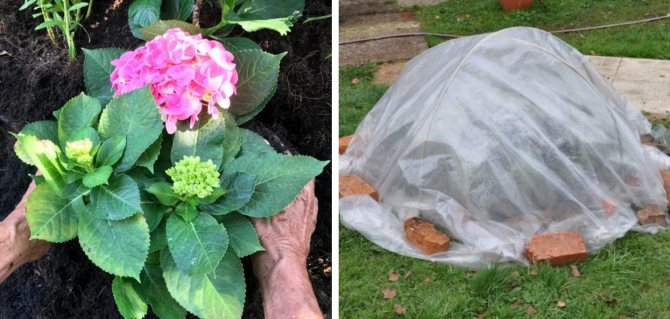

When a hydrangea variety was transplanted that cannot be cut off during the current period, it is recommended to insulate its aboveground part for the winter. If this is not done, fruit buds may suffer from low temperatures, as a result of which the bush will bloom only after a year. DYou can use white lutrasil, spunbond or other non-woven fabric for protection from the cold. When purchasing, it is recommended to choose thick agrofibre, with a fiber density of at least 30.0 g / 1 m².
Did you know? To give the snow-white inflorescences of garden hydrangea a blue or light blue color, it is worth adding acid to the soil. To do this, the ground in the near-trunk circle is watered with water with the addition of ammonium sulfate or potassium sulfate.
In the Urals and Siberia
In cold regions of the country, it is recommended to replant hydrangea at the beginning of the warm season. In the region of Siberia or the Urals, the shrub will then have time to grow new roots in about 4-6 months. The gardener should take into account that the cold in this area comes early, and the first night frosts may come as early as late August or early September. This means that work on the transplantation of a thermophilic culture must be carried out no later than the first ten days of May. It is optimal if at that moment the soil thaws two bayonets of the shovel into the depth.


In the Far East
The climate in this region is much milder than in northern Siberia, but the winter is just as long and frosty, and the spring is stormy and short, quickly turning into summer. Here, a spring transplant is also preferable, allowing the hydrangea to adapt and grow until winter. If, nevertheless, there is a need to complete this work later, then for this it is better to choose the end of summer: the second half of August or the first ten days of September.
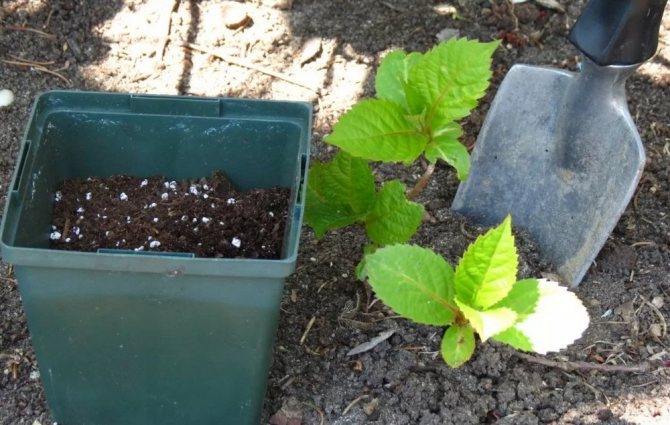

In this case, it is recommended to do a strong pruning at ground level, despite the type of hydrangea, and warmly cover the surface of the soil, under which the root ball is located. Warming is carried out with the onset of stable subzero temperatures. In the Far East, this period falls around the beginning or mid-October.
Important! The gardener should not cover the hydrangea too early for the winter, as this can lead to the formation of fungus and mold on the aboveground part, as well as rotting of the roots. It is best to carry out insulation work when the average daily temperature drops below -10 ° C.
Hydrangea care after transplant
In the first year after transplanting (especially in the case of division), it is very important to monitor the moisture content of the soil. Watering should be regular, and in the first month it is desirable to carry it out with the addition of growth and root stimulants, such as Epin or Heteroauxin.
Advice! In the year after the spring transplant, do not let the hydrangea bloom (cut off the flower stalks). Let her spend all her energy on growing roots, and not on flowering.
Indeed, hydrangea loves well-moisturized soil. This is the flower that drinks a lot of water and always drinks.
But everything should be in moderation, the shrub also does not like overflow.
Also, do not forget to periodically loosen and weed the weed circle around the trunk.
In the near future, no additional fertilizing will be required for hydrangeas, but only if you have laid in a sufficient amount of fertilizer when preparing the nutrient soil to fill the planting hole.
By the way! The site already has a detailed article on how and with what to fertilize hydrangeas in spring and summer.
If in the future you want to change the color of your hydrangeas - make blue ones out of pink or vice versa, then you will need to adjust the acidity of the soil. This can be done with the help of special fertilizers and chemical compositions, which is described in detail in this material.
Hydrangeas can be pruned in both fall and spring. Moreover, even if you carried out autumn pruning (it is considered the main and most desirable), then in spring or summer (just before flowering), you should additionally cut out all thin shoots (less than 1 cm thick).
Note! You will find complete information on pruning hydrangeas in spring, and in autumn.
Depending on the type of shrub, its preparation for winter is also different. So, large-leaved hydrangea is not a frost-hardy shrub at all, so shelter is simply necessary for it.
Important! Read more about autumn care and preparing hydrangeas for winter in this article.
Why does hydrangea not bloom
Advice! The site has a detailed article describing the main reasons why hydrangea may not bloom.
Thus, replanting the hydrangea to another location is a boon for your shrub. The main thing is to carry out the procedure according to all the rules, including not forgetting to carefully look after it.And at what time: spring or autumn, it's up to you to decide. In principle, both options are permissible.
Video: hydrangea transplant
When is it better to transplant hydrangea: in spring or autumn, is it possible in summer
Hydrangeas are quite demanding, therefore, when transplanting them to another site, you should adhere to agronomic recommendations so that the bushes take on well and bloom profusely in the future. The best time of the year to plant this perennial crop is early spring. (from March to April inclusive), since there are long summer and autumn ahead, which means that before the arrival of severe frosts, the plants will have time to acclimatize after the procedure.


It is also permissible to plant shrubs in the fall (from the second half of September to the end of October), but in this case the gardener needs to protect them well from the cold, since even frost-resistant species may not survive the first winter.
The benefits of planting in the fall
Landscaping professionals recommend planting hydrangeas in a new area for the following reasons:
- there is more time for pre-planting preparation;
- in the spring the plant begins to prepare for flowering, therefore it is harder to endure the violation of the natural cycle, while in the fall it naturally enters a state of dormancy and is as ready as possible for transportation;
- there will be no late or poor flowering next season;
- the soil is well warmed up over the summer and retains warmth even after a cold snap, which allows rooting to occur faster;
- the culture is hygrophilous and especially needs to be moistened after moving to a new soil, and in the fall it rains a lot, so the problem of watering is partially solved even when the planting process takes place in the country or in a suburban area.
When can you transplant an adult hydrangea
It is recommended not to transplant plants in the summer., since hot weather, together with shock from disturbed roots, often lead to wilting and disease of the bush. Subsequently, the hydrangea can grow, but this will be preceded by long-term illness and adaptation. That is why the most successful periods for such works are spring and autumn. These are the seasons when the air temperature remains moderate for a long time and gradually rises or falls.
Did you know? Even the ancient Greeks noticed a huge need for hydrangea for moisture. This feature is reflected in the botanical name of the culture - hydrangea (hydrangea), consisting of the words "water" and "vessel".
What you need to know before starting a transplant
Pay attention to the future site for the hydrangea, it should be as similar as possible to the one where it grew before. It is desirable that the place in the garden be well lit by the sun, protected from cold and gusty winds. The composition of the soil is also an important factor for the normal development of the bush after transshipment.
Soil preparation
If you intend to replant the plant in the spring, then it is better to start preparing the soil in the fall. In fact, there are several opinions among gardeners about the best transplant times for this crop.
Many people prefer to replant the hydrangea in the spring, others are supporters of the autumn period, and still others argue that the plant takes root well in the summer, the main thing is that the flowering ends.
So, let's consider all the terms, but first, let's take a closer look at the preparation of the land on the site. What needs to be added to the soil and how to properly prepare the site for hydrangea:
- When digging in the autumn, organic fertilizers must be applied to the soil.
- The composition may be as follows: peat, fallen needles from forests, sand from the river. Each component should be applied to the soil in an amount of 5 kg per square meter.
- Mineral supplements are also essential for the earth.Superphosphate and potassium formulations are suitable as minerals.
- All components mix well with the ground, after which the site is leveled with a rake.
- All useful components will mix with the soil and begin to work to enrich its structure.
It is desirable that the enrichment process is completed before planting the hydrangea in a month, and the ideal option would be to prepare the land in the fall. Then in the spring the soil will be completely balanced and ready for the plant to accept.
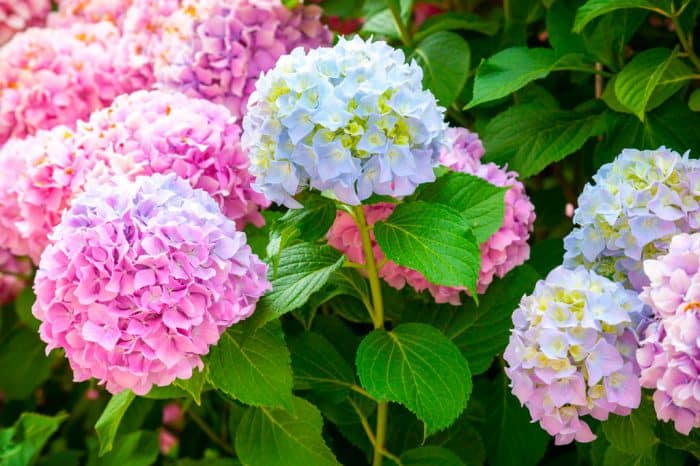

Planting pit preparation
There are also requirements for planting pits, and they should be known for sure:
- The preparation of the pit should take place in advance, at least one to two months in advance.
- A spacious hole should be dug in with dimensions: 0.5 X 0.5 m in depth and width.
- It is necessary to lay a drainage layer at the bottom. They can serve as finely crushed brick, river pebbles or sand.
Only after laying the drainage layer is the same nutrient layer that was mentioned above being prepared. That is, the earth is scooped out of the pit and mixed with organic matter and minerals aside, only then it is laid back.
For planting, a leaf layer of earth, peat, humus and sand are taken. Urea is added in an amount of 0.2 g, potassium sulfate 0.2 g, superphosphate 0.6 g. All components are mixed and put into the planting pit, which must be settled.
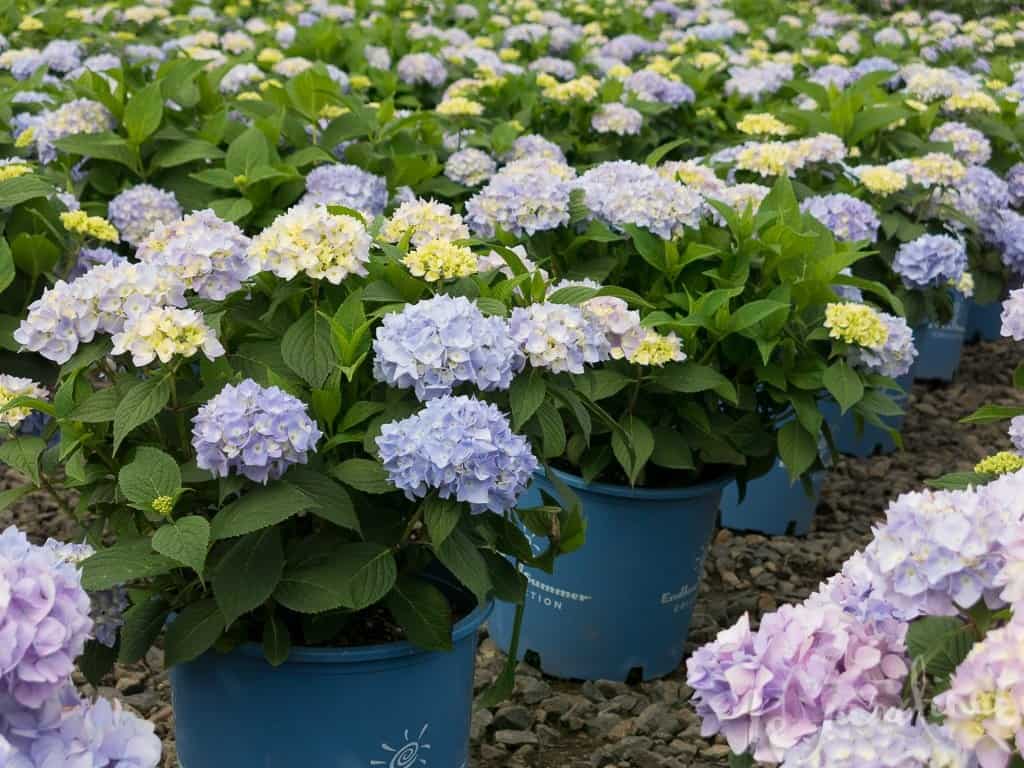

Planting a plant in the soil
An important step is the correct planting of the plant, for this it is necessary to remember that the hydrangea cannot be deeply buried in the soil, the root collar must remain flush with the soil.
That the bush after transplanting did not tilt and did not fall on its side, a support is added to the pit, which will ensure the plant grows evenly. Be sure to mulch the trunk circle; humus, sawdust, bark, previously crushed, can be used as a mulching material.
Such simple rules will help you cope with a plant transplant with minimal damage to it.
Hydrangea is considered an undemanding plant, but during its transplanting it requires increased attention and knowledge of the features and some nuances. How the process depends on the time of year will be discussed in the following paragraphs.
How to properly transplant a hydrangea to a new location
Gardeners have a rule: in the spring, it is recommended to move a plant with an open root system to another place before the buds swell and bloom. If the moment is missed, the transplant is postponed until autumn.
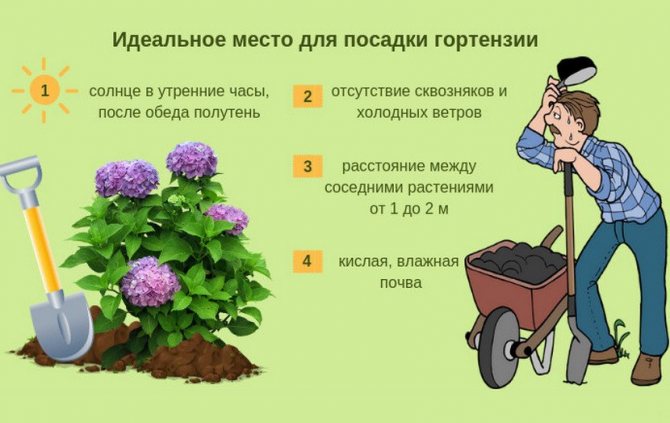

Before landing, you need to choose a suitable location, it must be protected from the north wind and be in partial shade. There are also requirements for the substrate in which the roots will be located: the soil must be fertile, humus, loose, permeable to water and oxygen, slightly moist, with a slightly acidic pH.
Important! If, after removing the bush from the pot, it turned out that the root ball is very compacted, then before planting the gardener should gently knead it with his hands, which will help the plant soon form new roots.
Planting hydrangeas:
- A hole is dug in the soil at the chosen place. Its dimensions should be twice as large as the root ball of the seedling.
- A mixture of soil with sour peat (15–30 cm) is placed at the bottom of the recess, after which the plant is placed on top to a depth corresponding to that at which it has grown so far.
- If a bush that is already growing in an open space moves to a new place, it should be carefully dug out so that as many roots as possible are preserved. This will reduce the shock associated with displacement. An adult plant is more convenient to carry together, so two people will be needed for such work.
- In the case when a part of an old bush is transplanted (during rejuvenation), then after removing it from the soil, it is necessary to carefully examine the root system and remove the oldest, thickest or dead parts with a pruner.
- Then the planting hole is filled with prepared soil to half, tamped well and watered abundantly. After the moisture has been absorbed into the soil, the depression is filled with soil to the surface level.
- After planting, the soil around the bush should be carefully compacted, creating a small depression to retain water while watering in the root zone.
- Next, the trunk circle is mulched using crushed pine bark or large sawdust for this.
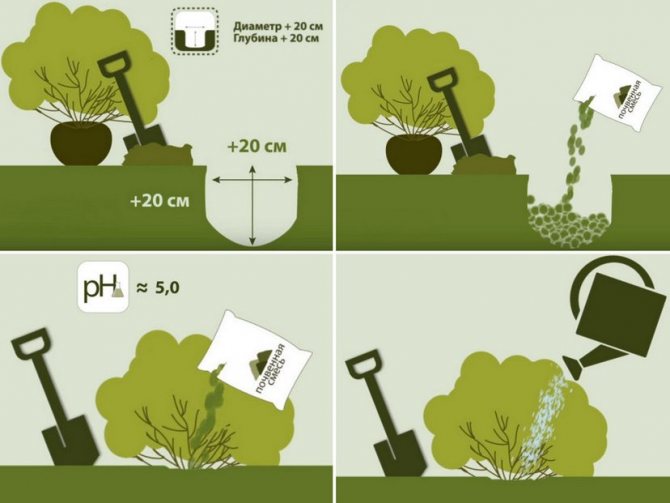

In autumn
In this season, replanting shrubs should be carried out as early as possible. A signal to the fact that the time has come for such events is a decrease in average daily temperatures to + 15 ... + 18 ° C. Hydrangeas planted in the fall are usually not pruned to avoid weakening the shrub before the long winter.
Video: Transplanting hydrangeas in the fall
In order for disturbed plants to survive prolonged cold weather without loss, it is advisable to insulate them. To do this, a thick layer of mulch is laid in the near-stem zone, which will protect the roots from freezing, and the shoots are wrapped in 2-3 layers of agrofibre.
Find out why hydrangea grows poorly.
In the spring
Bushes transplanted in early spring (from March to April) definitely need to remove the aboveground part. The clipping must be adapted to the requirements of the species, because plants form buds in different ways, and by improper pruning, the grower may lose flowering in the coming season.
How to prune different types of hydrangeas:
- On last year's shoots, garden, large-leaved, paniculate, tree-like and weaving hydrangeas form inflorescences, so in the spring you can carry out a very delicate cut of the last developed pair of buds, as well as remove the affected and damaged branches. Pruning the plant harder, for example to make it more compact, will not bloom this season.
- Bouquet and shrub varieties form fruit buds on the branches of the current year, therefore, after spring planting, they can be severely pruned. Such a procedure will have a beneficial effect on the general development of the seedling, it forms many young shoots and will bloom profusely in the summer.
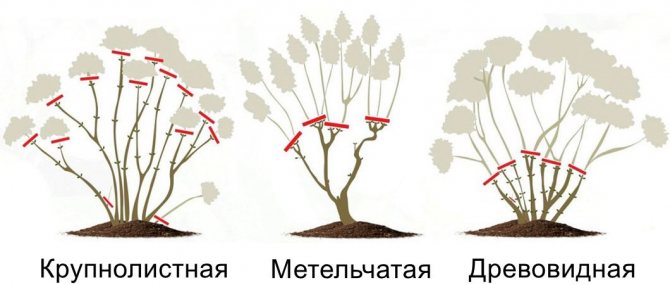

In summer
Sometimes in the summer it is necessary to urgently transplant a hydrangea from a pot. It happens that its volume became small for the root system or the bush began to hurt. This can be done if a transshipment method is used, during which not a single root is damaged.
Important! To carry out a hydrangea transplant using the transshipment method, choose a rainy or cloudy day. After the procedure, the plant is shaded using spunbond or lutrasil for 7
–
10 days.
Transplanting a potted hydrangea in summer:
- They dig a wide and deep hole, fill loose acidic soil on the bottom.
- The plant is not watered in any way.
- The walls of the container are tapped with a knife handle in order to separate the soil lump, after which it is carefully removed and placed in the prepared soil recess.
- Next, the side voids are covered with earth, the bush is watered using at least 5 liters of water, they wait until the moisture is absorbed, and, if necessary, add the substrate.
- Be sure to lay a mulching layer.
- The roots of a plant moved to another place in the summer must be constantly moist, so it must be watered frequently, at least twice a week pouring out 1.5–2 liters of water.


Proper care after transplant
The normal growth and development of a newly transplanted plant depends not only on the transplant itself, but also on how the gardener will properly care for the plant. In the autumn period, the rains begin to fall much more often than in the spring or summer, so you need to water the plant much less often.
For irrigation, use only purified soft water. The plant does not tolerate lime at all. It is best to collect rainwater, which is ideal for watering hydrangeas.Tap water must be defended and heated for some time.
To avoid plant disease with leaf chlorosis, the liquid must be softened with the help of components such as:
- Lemon juice;
- Vinegar;
- Several grams of electrolyte.
In addition, in order to avoid crop diseases, iron salts are introduced into the soil:
- ferrophyte,
- iron chelate,
- inkstone.
On a note. Since hydrangea is a moisture-loving culture, you need to pour two buckets a week under each bush.
In order for a hydrangea to bloom magnificently, it needs a lot of minerals, so fertilizers are applied at least four times a year.
If a gardener wants to change the color of hydrangea flowers, he needs to add iron salts and alum to the soil twice a month. If alum is introduced into the soil only on one side, on the other - to leave the soil in the same composition, then on one shrub you can get inflorescences of different colors. In order to see how a changeable flower changes color of inflorescences, you need only about ten crystals of ammonium-potassium or potassium alum, diluted in two liters of water.


Hydrangea can help refresh and decorate your garden. Only one bush is able to turn the planting into a luxurious alley with marvelous inflorescences
For feeding, in most cases, organic fertilizers are used, such as mullein. From mineral - ammonium sulfate, potassium sulfate are suitable.
Fertilizers are applied three times throughout the season:
- In early spring, to form strong shoots;
- In June, before buds begin to form;
- During the summer months, when the culture is in full bloom.
In order to avoid the appearance of rot on the root system in the first year after transplanting, it is recommended to water the plant with a weak solution of potassium permanganate or any other fungicide.
In the autumn months, it is recommended to prune shrubs, while remembering to process the cut points. It is not worth pruning the plant too much; instead, it is better to cut off the leaves at the base of the shrub. If the plant is planted in a region with a harsh winter climate, then it should be hilled in preparation for wintering.
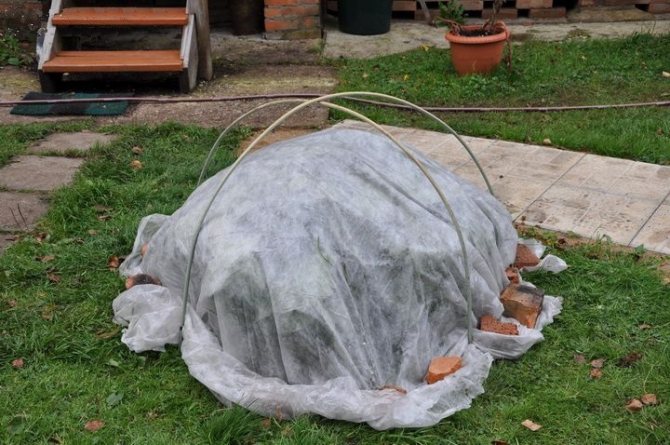

A rather warm and snowy winter period allows even species that love warmth (serrated and large-leaved hydrangea) to winter without shelter. However, it should be borne in mind that winter will be frosty or warm, no one knows exactly how and how much snow will fall. Better to be safe ...
In Siberia and the Moscow region, it is important to properly prepare the plant for wintering. To do this, in the second decade of October, in addition to hilling, the plantings should be covered with agrospan or perforated plastic wrap folded in two layers. In the last days of October, the leaves of the bush are bent to the ground and covered with dry fallen leaves or spruce branches.
How often can you replant
It is not recommended to disturb the shrub too often, because even after a very successful and seemingly painless transplant, the plant is under stress. This condition leads to long-term adaptation, during which it gets sick and cannot normally develop the aboveground and underground parts. In the most unfortunate cases, this ends with the death of the hydrangea.
It will be interesting for you to learn how to keep hydrangeas in the garden and at home during the winter.
Given the negative consequences, the transplant is recommended only when necessary. For example, next to a flower bed, a tall tree has grown strongly and shades everything around, or an old bush is excessively thickened with shoots, and it must be rejuvenated by the separation method.
Is it possible to transplant a flowering hydrangea
Experienced gardeners do not recommend disturbing the root system of a flowering shrub.... Stress will surely lead to wilting of inflorescences and dropping of blossoming buds. This applies equally to indoor and outdoor hydrangeas of any variety.It is worth waiting not only for the end of flowering, but also for the onset of a suitable period of the year.
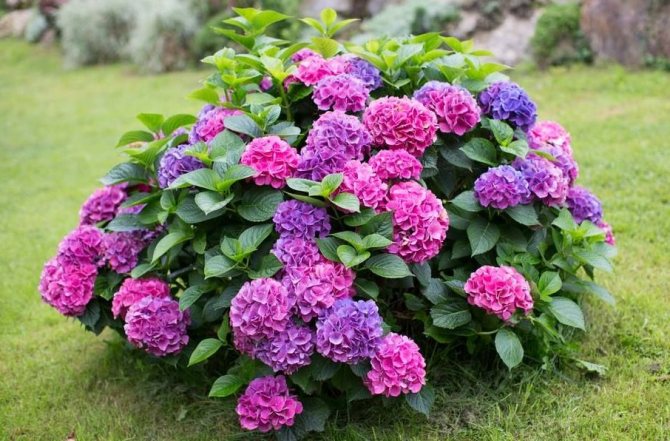

Transplanting a shrub is not too difficult for an experienced gardener. But it should be borne in mind that hydrangea is a very demanding plant, and you need to transplant only in a suitable season for this, choosing the right phase of culture development.

